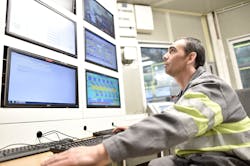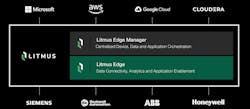Well known for supplying materials and services to the residential and commercial construction industries, Saint-Gobain also supplies the automotive and transportation, aerospace, health and biomedical, industrial equipment, security, and household appliance industries. At Saint-Gobain Sekurit, a division of Saint Gobain and leader in automotive glazing for more than 80 years, the company set out to achieve a centralized Industry 4.0 strategy.
The company’s Industry 4.0 strategy is to “transform its shop floors into a digital workplace and generalize a data-driven approach,” said Sebastien Thuillier, digital transformation program manager at Saint-Gobain Sekurit. “The end goal is to be able to provide the right data to the right person for the right purpose.”
Driving this strategy was the company’s realization that it lacked a connectivity standard allowing to collect the massive amounts of production data trapped in machines, historians, and quality systems efficiently and easily. Also, like most manufacturing operations, Saint-Gobain Sekurit uses machines from “a wide variety of vendors, including brownfield assets, which can add up to 20 different machines on each production line,” said Thuillier.
Now consider the scope of Saint-Gobain Sekurit’s Industry 4.0 initiative in light of the fact that this division has more than 30 plants and around 16,000 employees worldwide. (View an illustration of Saint Gobain Sekurit's automotive glazing manufacturing process).
Edge integration
A key aspect of the transformation identified by Saint-Gobain Sekurit is the use of Litmus Edge—an industrial edge computing platform that can reportedly collect data from any plant floor asset, includes key performance indicator (KPI) and analytics applications, and can integrate with any cloud or enterprise system.
“Saint-Gobain Sekurit chose to install Litmus Edge on the shop floor for its ability to connect to the full breadth of OT (operations technology) and IT assets with out-of-the-box support for any driver, protocol or connection,” said Marc Dekker, senior technical account manager at Litmus. “They started small and then added data points and use cases as the solution showed a return on investment.”
To date, Saint-Gobain Sekurit has implemented Litmus Edge in 20 of its plants in the first year of the project (2018-2019), with four more plants added in 2020. Thuillier expects another four plants will be equipped with Litmus Edge in 2021.
Implementation results
In each of the Saint-Gobain Sekurit plants where the Litmus Edge platform has been implemented, it has been installed on HPE GL20 gateways with the Litmus Edge Manager hosted on-premises to manage devices at each location, said Dekker. The HPE gateways then send data to the company’s MES and historian systems.
Results of the implementation reported by Saint-Gobain Sekurit include:
- Collecting a multitude of production data points that can be accessed by anyone in the plant;
- Consolidating views of all data across all cells;
- Enabling live analytics with dashboards, alerts, and process improvement directions; and
- Performing offline machine learning on historical data by collecting, storing, analyzing, and building an analytics model.
Thuillier offered an example of how Saint-Gobain Sekurit uses online machine learning through auto regulation. He said, “by collecting machine, process, and quality data on a product, we can define links or laws to build a model that can predict the quality of a product based on parameters and measured inputs. The collected data helps us to build these models and test them for improved product quality.”
Data insights provided by Litmus Edge have improved Saint-Gobain Sekurit’s operations and production through the delivery of immediate alerts from equipment whenever there is a deviation in KPIs. This has resulted in “better reactivity, quicker decisions, and fewer losses,” Thuillier said. “And for our daily meetings, we can more easily reference previous data to make sharper analyses.”
Leaders relevant to this article:



